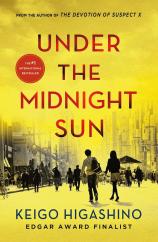Under the Midnight Sun
Review
Under the Midnight Sun
In his native Japan, Keigo Higashino is a bestselling mystery author on the level of James Patterson or Michael Connelly, but he’s still largely unknown in the U.S. Aside from his 2012 Edgar Award-nominated book THE DEVOTION OF SUSPECT X and a handful of other novels, most of his deep back catalog hasn’t yet reached American bookstores. But it’s possible that UNDER THE MIDNIGHT SUN, a twisty, intense mystery that plays out over 20 years and more than 500 pages, will bring Higashino the recognition in America he deserves.
In 1973, Yosuke Kirihara, an Osaka pawnbroker, is found stabbed to death in an abandoned building. An investigation turns up some predictable leads. The victim seems to have been having an affair with one of his clients, while his younger, bored wife may be engaged in extramarital activities of her own. But after a few months, Detective Sasagaki’s investigation stalls, and the case languishes.
For the first 50 pages, Higashino’s novel seems like a solid, if not particularly innovative, detective story. But after the long first chapter, things take a sharp left turn, and it becomes clear this is no ordinary whodunit. The focus shifts away from Sasagaki (the detective won’t reappear until halfway through the book) and toward Yukiho Karasawa, the 11-year-old daughter of the victim’s suspected paramour, and Ryo Kirahira, his son and Yukiho’s schoolmate.
"[A]fter the long first chapter, things take a sharp left turn, and it becomes clear this is no ordinary whodunit.... Mystery fans will delight in Higashino’s pastiche of mystery tropes."
The rest of UNDER THE MIDNIGHT SUN, which was first published in Japan in 1999, follows this mysterious pair over the course of two decades. We see them through the eyes of dozens of their friends, lovers and acquaintances, including the real estate agent who is with Yukiho when she discovers her mother dead in their apartment following a gas accident (or was it suicide?); Tomohiko, Ryo’s reluctant partner in a video-game-pirating enterprise at the height of the Super Mario Bros. craze; and Makoto, Yukiho’s confused and unhappy husband.
Clever clues Higashino sprinkles throughout his novel leave no doubt that Ryo and Yukiho’s lives are somehow linked. Yet we never see them interact, and the exact nature of their relationship remains vague. But wherever either goes, misfortune follows. Yukiho’s friends are violently attacked; Ryo’s associates turn up dead or vanish without a trace.
The brilliant and antisocial Ryo is a perpetual outsider, using his wits to engage in a life of crime and elude the authorities. Yukiho relies on her beauty and grace to charm virtually everyone she meets. Yet a few people sense something is amiss with the stunning ice queen. “[T]here’s something else to her, a darkness under the surface,” Kazunari tells Imaeda, the detective he’s hired to investigate the now-divorced Yukiho, who’s about to wed his cousin, an executive at the family’s pharmaceutical company. Imaeda gets close to ferreting out the truth, and his investigation eventually pulls Sasagaki back into the case.
Mystery fans will delight in Higashino’s pastiche of mystery tropes. Aside from Yukiho, one of the most frightening femme fatales ever committed to page, there’s Imaeda, the hard-boiled detective, and Sasagaki, the world-weary but indefatigable policeman. Talk of poisoned postage stamps and the best way to commit murder via cyanide nods to Agatha Christie, but there’s also a case of industrial espionage and shadowy yakuza figures from Japan’s criminal underworld. Not to mention the revelation that the police have been dealing with a locked-room mystery the entire time; they just didn’t realize it.
Higashino mixes together those disparate elements and dumps them into a uniquely Japanese setting, taking the reader from Osaka’s rough-and-tumble back streets to the sleek shop floors of exclusive Tokyo boutiques. Pop culture references abound, as characters drop mentions of “Twin Peaks,” video games like Space Invaders, and J-pop singer Seiko Matsuda. Occasionally, all this chatter distracts --- the book could have done with fewer baseball-related digressions, for one. The to-the-point prose rarely sings, though whether that’s a fault to be laid at the feet of the author or translator is hard to say.
Those looking for a tied-with-a-bow resolution to the novel’s big mystery won’t be totally satisfied with the conclusion of UNDER THE MIDNIGHT SUN. Sure, we find out who killed Yosuke. But the bigger question of why is a bit harder to unravel, given that Higashino offers only the narrowest peek into the minds of his villains. Their toxic partnership remains an enigma to the end, which may be the most terrifying thing of all.
Reviewed by Megan Elliott on November 11, 2016



